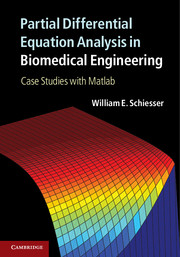Book contents
- Frontmatter
- Contents
- Preface
- 1 Introduction to partial differential equation integration in space and time
- 2 Antibody binding kinetics
- 3 Acid-mediated tumor growth
- 4 Retinal O2 transport
- 5 Hemodialyzer dynamics
- 6 Epidermal wound healing
- 7 Drug distribution from a polymer matrix
- Appendix 1 Origin of convection-diffusion-reaction PDEs
- Appendix 2 Stiffness and eigenvalue analysis of ODE systems
- Index
Preface
Published online by Cambridge University Press: 05 December 2012
- Frontmatter
- Contents
- Preface
- 1 Introduction to partial differential equation integration in space and time
- 2 Antibody binding kinetics
- 3 Acid-mediated tumor growth
- 4 Retinal O2 transport
- 5 Hemodialyzer dynamics
- 6 Epidermal wound healing
- 7 Drug distribution from a polymer matrix
- Appendix 1 Origin of convection-diffusion-reaction PDEs
- Appendix 2 Stiffness and eigenvalue analysis of ODE systems
- Index
Summary
This book is an introduction to the mathematical modeling of biomedical engineering systems. In particular, models based on partial differential equations (PDEs) are presented: antibody binding kinetics, acid-mediated tumor growth, retinal O2 transport, hemodialyzer dynamics, epidermal wound healing, and polymer matrix drug delivery.
The numerical solution of the model equations is through a single, well-established method for PDEs, the method of lines (MOL), in which the spatial derivatives in the PDEs are replaced with algebraic approximations and a system of ordinary differential equations (ODEs) in an initial value variable, typically time, follows. The spatial approximations are finite differences (FDs), although other approximations could easily be accommodated within the MOL format, e.g., finite elements, finite volumes, spectral methods, Galerkin methods such as collocation, meshfree methods. The final result is a set of routines that numerically integrates the ODEs; the format of these routines is basically the same throughout the book.
To facilitate understanding of the PDE analysis, an introduction to the numerical methods and associated computational routines is presented in the first chapter. Then each application is cross referenced to this introduction in each step where some additional explanation is helpful.
In each example, we follow a combination of the following steps:
• Statement of the model PDE, along with the associated auxiliary (initial and boundary) conditions. This introduction to the model contains a reference to the original source and possibly related literature, and includes some discussion of the underlying biophysics, biochemistry, and physiology.
[…]
Information
- Type
- Chapter
- Information
- Partial Differential Equation Analysis in Biomedical EngineeringCase Studies with Matlab, pp. ix - xPublisher: Cambridge University PressPrint publication year: 2012
